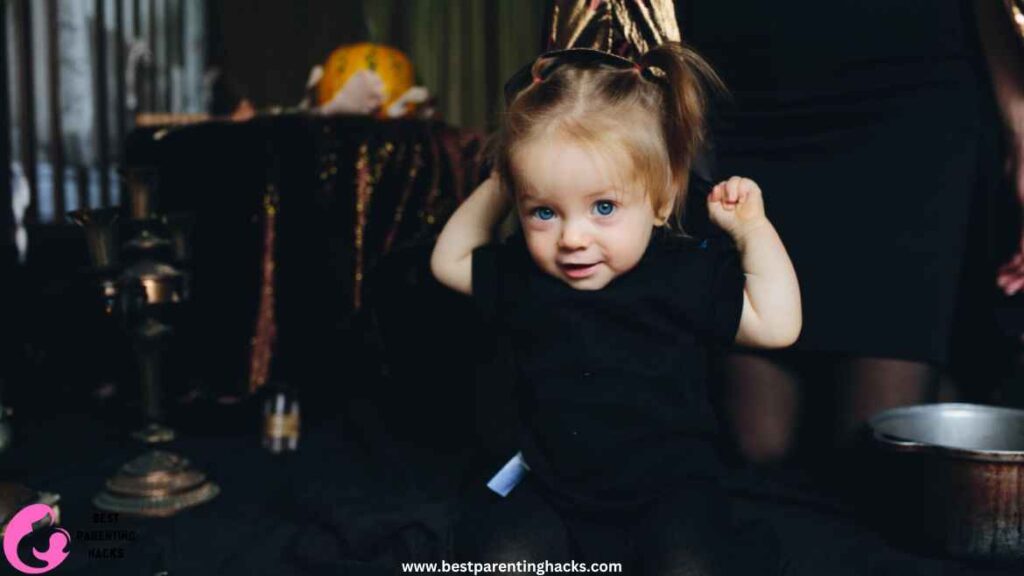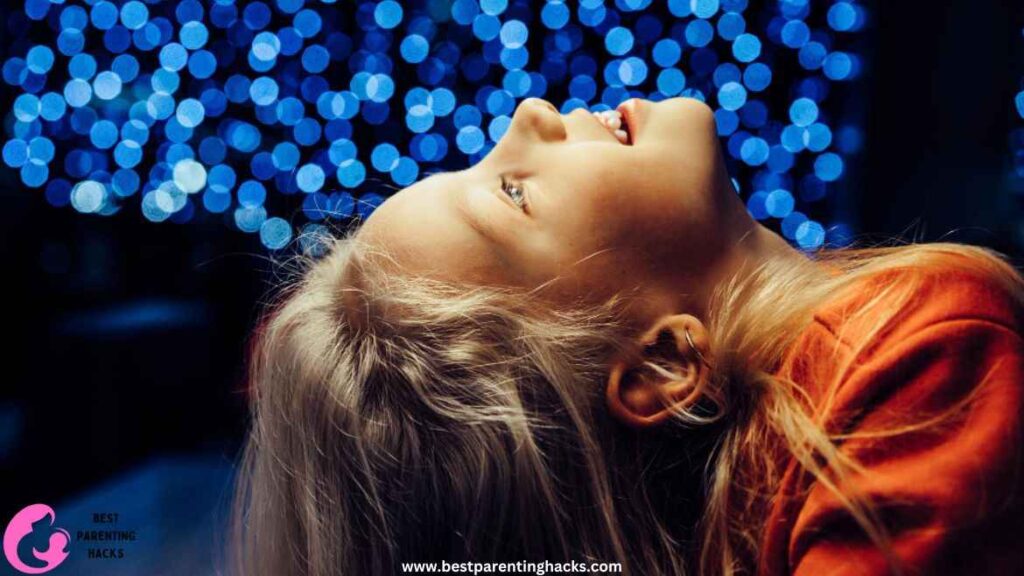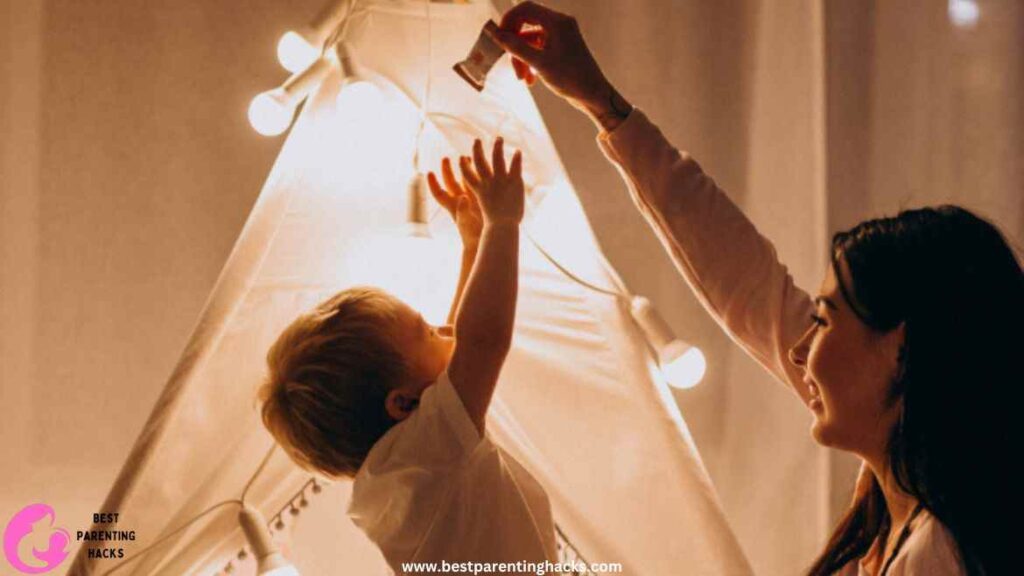Table of Contents
As a mother, I have been through various stages of my child’s development, each with its own unique mysteries and worries. One such stage that caught my attention was my baby’s infatuation with lights. This was a cute and fascinating preoccupation that ranged from a squealing of excitement at the sight of Christmas lights sparkling to a fascinated stare at the gentle glow of a nightlight. Although this is a typical scenario in many homes, it begs the question of what is so captivating about it. Is it only a passing fancy, or does it represent something more significant in their growth as people?
In response to the query raised in the title, “Why is my baby obsessed with lights?” the explanation lies in how infants engage with and comprehend their environment. Lights can offer a thrilling experience, for a newborn as they have the ability to change in color and brightness. This interest reflects their developing sensory and cognitive capacities rather than merely a whim. As they grow older their fascination, with lights demonstrates the progression of their minds and their increasing understanding and engagement with the world, around them.

Understanding the Fascination: Why Babies Love Lights
Babies are naturally attracted to experiences as it helps them understand the world they live in. Specifically, lights offer an informative encounter. The contrast and brightness of lights contribute to the development of their eyesight in the early months, allowing them to recognize patterns and forms. Their cognitive growth depends on this visual engagement. Observing my infant’s eyes trace the movement of a light source, I became aware of how this easy task was improving his attention span and visual tracking abilities.
Furthermore, lights frequently exhibit variations in hue and intensity, providing a dynamic visual experience. This variety not only keeps them entertained but also helps to grow their brains. It builds the foundation for critical thinking and problem-solving abilities later in life by encouraging children to notice, consider, and respond to changes in their surroundings.
1. Visual Stimulation: Unlike other commonplace items in a baby’s surroundings, lights offer unparalleled visual stimulation. This is a necessary stimulant for the development of vision.
2. Cognitive Engagement: A baby’s cognitive abilities are stimulated by the flickering, dimming, and brightening of lights, which helps them anticipate and respond to these changes.
3. Sensory Exploration: Infants learn about the world via their senses, and lights provide an interesting sensory experience. Unlike other items, lights arouse their sense of sight with brightness and color.
4. Emotional Reaction: Babies frequently react joyfully when they see lights. Their general pleasure and well-being are enhanced by their enthusiasm and grins while engaging with lights, which show an emotional reaction.
You Might Also Like to Read: Letting Baby Taste Food at 2 Months? What Should We Do?
Is It Normal? Debunking Myths and Concerns
Like many parents, I was curious if my baby’s great interest in lights was typical when it first appeared. I found out after doing a lot of research and talking to physicians that it’s not only normal but also a sign of healthy growth. However, this understanding is frequently obscured by several misconceptions and worries.
Myth 1: Obsession with Lights Is Abnormal: A lot of parents are concerned that their child’s obsession with lights is odd or a sign of a developmental problem. Most newborns go through this fascination as a normal developmental stage.
2. Concern: Impact on Vision: It’s a widespread worry that a baby’s vision might be harmed by looking at lights. Normal home lights don’t endanger their eyesight, however, it’s still vital to make sure they’re not too bright.
3. Myth: Indicates Attention Deficit: A fixation on lights may be an indication of attention deficit disorder, according to some parents. But frequently, this conduct is only a phase and has nothing to do with concentration problems.
4. Concern: Could It Be a Sign of Autism?: While autism is linked to repeated behaviors and fixations, an interest in lights on its own—especially in the absence of other symptoms—is usually not a reason for alarm.
5. Myth: It Stunts Other Aspects of Development: Another misconception is that a mild compulsion might impede the development of other talents, such as motor or social skills. Quite the contrary: as newborns reach out to lights or share their enthusiasm with others, this curiosity can support general development, including motor skills and social interaction.
You Might Also Like to Read: Signs of an Under-stimulated Baby

The Developmental Significance of Light Fascination
As I saw my kid become fascinated with lights, I couldn’t help but be amazed at the developmental steps that this behavior represented. This modest curiosity is a starting point for comprehending many facets of their development.
1. Visual Development: Playing with lights aids in the development of a baby’s depth awareness and visual tracking abilities. Seeing how my baby’s ability to follow moving lights has developed over time is intriguing.
2. Cognitive Growth: Seeing and responding to lights is a process that promotes cognitive growth. It fosters in infants the development of causal reasoning, a basic cognitive ability.
3. Motor Skills: Reaching out to touch or reach for lights promotes the development of motor skills. I could see my baby’s hand-eye coordination getting better as he reached for light.
4. Language and Communication: It’s interesting to note that lighting can also influence language development. Babies are exercising communication skills as they attempt to indicate their interest by pointing at lights. ‘Light’ was one of my baby’s first words, indicating how his passion influenced his language development.
5. Emotional and Social Development: Babies’ emotional health is influenced by the happiness and excitement that lights provide them. My child happily showed our family members the lights highlighting how sharing their fascination, with lighting helps build connections.

Managing Your Baby’s Light Obsession
Finding a balance between fostering a baby’s interest and protecting their general well-being is key to managing their fascination with lights. I found the following four steps to be helpful:
1. Moderate Exposure: It’s vital to regulate a baby’s exposure to light while still allowing them to explore it. To prevent overstimulation, I made sure my kid wasn’t exposed to too bright or flashing lights, especially before bedtime.
2. Create a Stimulating Environment: I discovered that giving my infant access to a range of light sources, such as dimmable lights, and light-up toys, allowed him to safely explore his curiosity in a supervised setting.
3. Encourage Other Interests: In addition to light play, I included additional sensory exercises to make sure the child’s development was well-rounded. This included spending time outside, listening to soothing music, and playing with tactile toys, all of which served to enhance his sensory experiences.
4. Set a Routine: He was able to control his mild addiction by creating a routine. I made sure that we had periods of light play during the day that didn’t conflict with his sleep or other essential tasks.

When to Seek Professional Advice
Although a baby’s fascination with lights is typically a natural aspect of their development, there are times when consulting a specialist is required. This is how I would go about it:
• Monitor Developmental Milestones: To make sure that my baby’s infatuation with lights wasn’t impeding his general development, I kept a careful check on other developmental milestones. Had I observed any lags or regressions, I would have consulted a specialist.
• observe Behavioral Changes: I would have thought about seeing a pediatrician if the light preoccupation had resulted in behavioral changes like irritation or withdrawal from other activities.
• Check for Overstimulation: It’s critical to make sure that an excessive amount of light fixation isn’t occurring. Had my infant displayed symptoms of sensory overload, such as extreme fussiness or difficulty falling asleep, I would have spoken with a medical professional.
•Seek Advice for Peace of Mind: Occasionally, seeking the counsel of a professional might bring about peace of mind. Had I ever been excessively worried about my infant’s infatuation with lights, I would have looked for guidance only to allay my concerns.

Conclusion
When I go back and consider my baby’s path with his obsession with lights, I notice how this seemingly little interest was a doorway into his world of growth. It was a stage in his learning and development, not merely a fad. I learned from this experience how crucial it is to see these little interests through the prism of developmental stages.
As parents, we frequently question whether our child’s actions are typical or a sign of something more serious. I discovered the importance of observation, education, and patience throughout my path. Knowing the reasons for these fascinations can help us move from being concerned to being appreciative of and in awe of their growth process.
This trip has also served as a reminder of the magic and delight of childhood. My infant taught me to take joy in the small things when I saw how happy his eyes became at the sight of a basic light source. These are the kinds of experiences that give parenthood its special and fulfilling qualities.
To put it simply a baby’s fascination, with lights is completely normal and beneficial, for their development. It shows that they are growing and exploring their sense of curiosity, logical thinking, and sensory exploration. As parents, we have the task of nurturing our children’s passions while also ensuring their health and happiness. Consequently, we have the opportunity to witness firsthand the journey through which our young ones acquire knowledge, about the world surrounding them.
FAQs
Why does light captivate my infant so much?
Babies are drawn to lights because, in my experience, they are bright and active. It is a byproduct of their insatiable curiosity and sensory growth.
Is a baby’s obsession with lights normal?
Of course! This preoccupation is a normal stage of growth. It demonstrates that your child is exploring and learning about their surroundings.
Is a baby’s fixation on lights a sign of any developmental problems?
An interest in lighting is generally acceptable and beneficial. However, it’s always a good idea to speak with a pediatrician if you have worries about your child’s growth.
How can I deal with my infant’s light obsession?
In my experience, it all comes down to balance. Before putting your baby to sleep, especially, make sure they have a peaceful space and let them explore lighting.
Should I support my infant’s fascination with lights?
It can be advantageous for their sensory development to be stimulated. Toys with interconnected lights could be fantastic educational and discovery tools.
How can newborns play with lights safely?
Safe methods include observing lights from a distance or playing with light-up toys under supervision. Make sure the lighting is never too intense or bright.
How long does a baby go through the light attraction phase?
Though every kid is unique, this stage usually lasts until they grow out of it or find other interests as their sensory systems develop. For me, it persisted for a few months before shifting to other interests.




